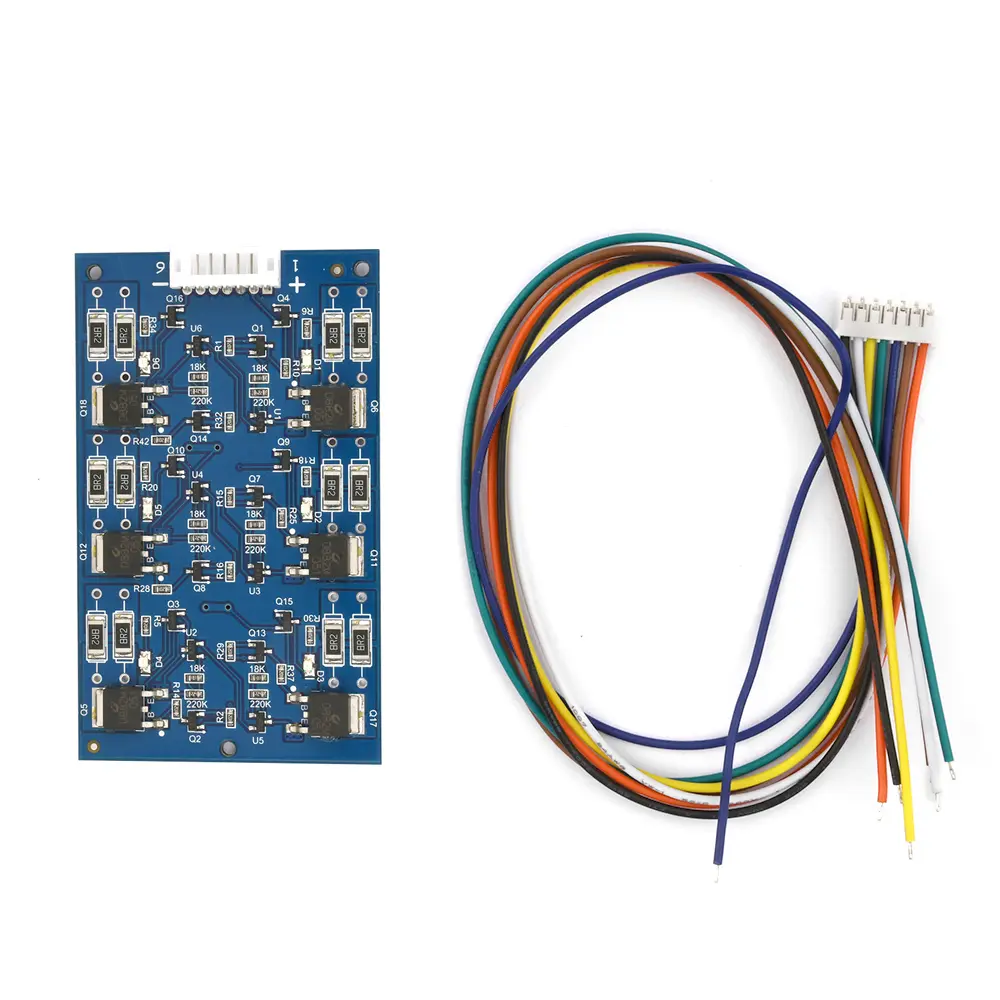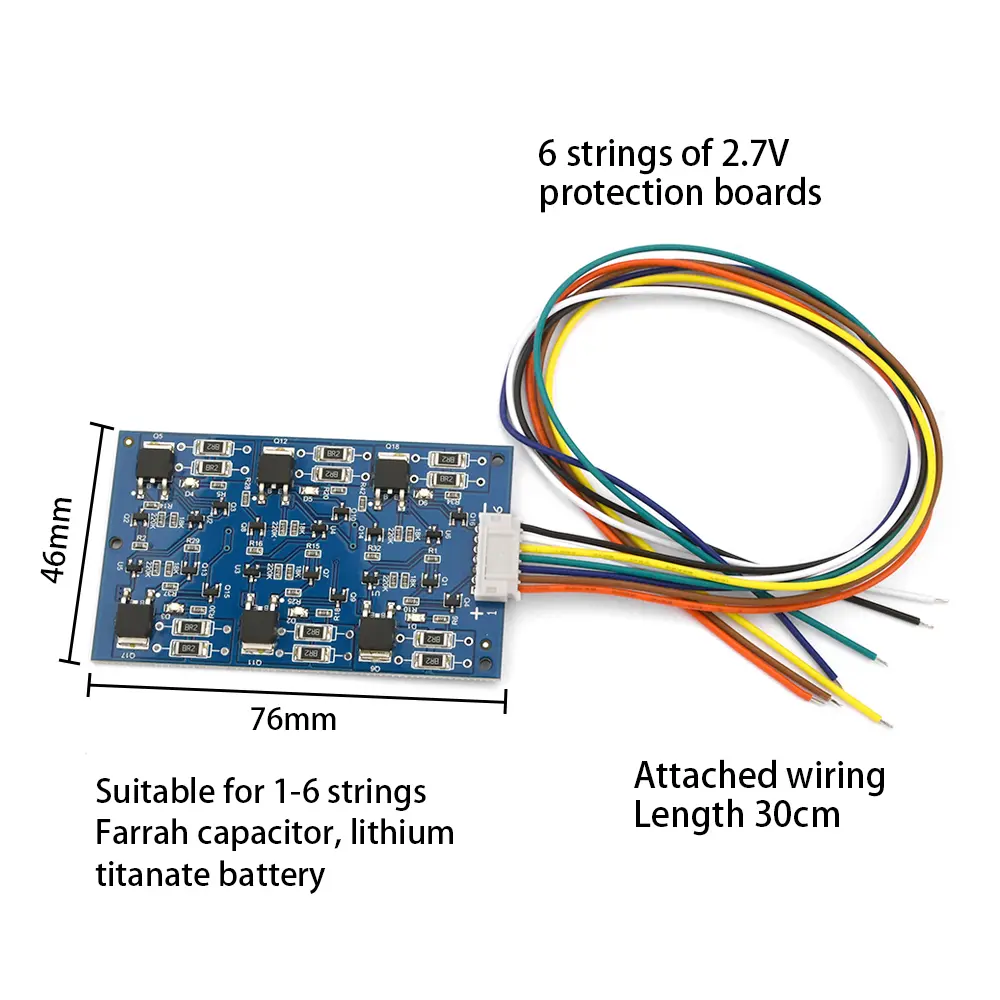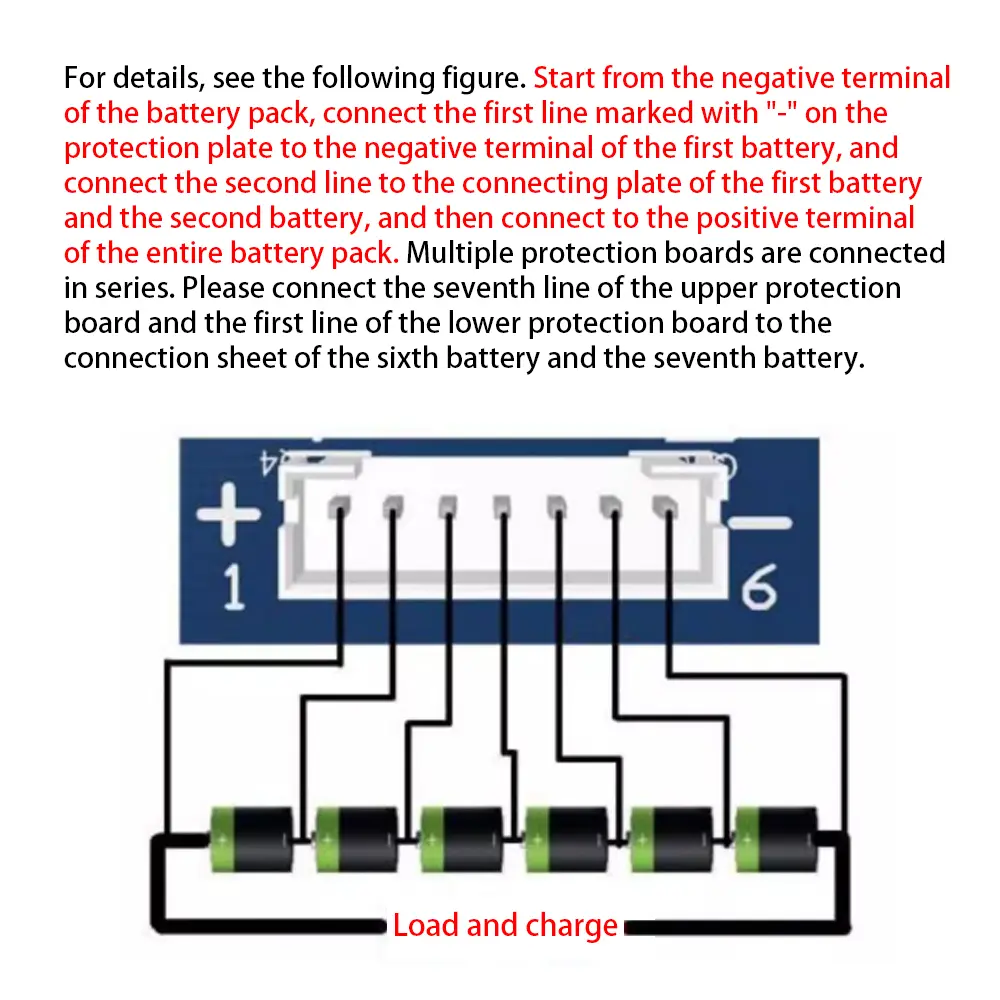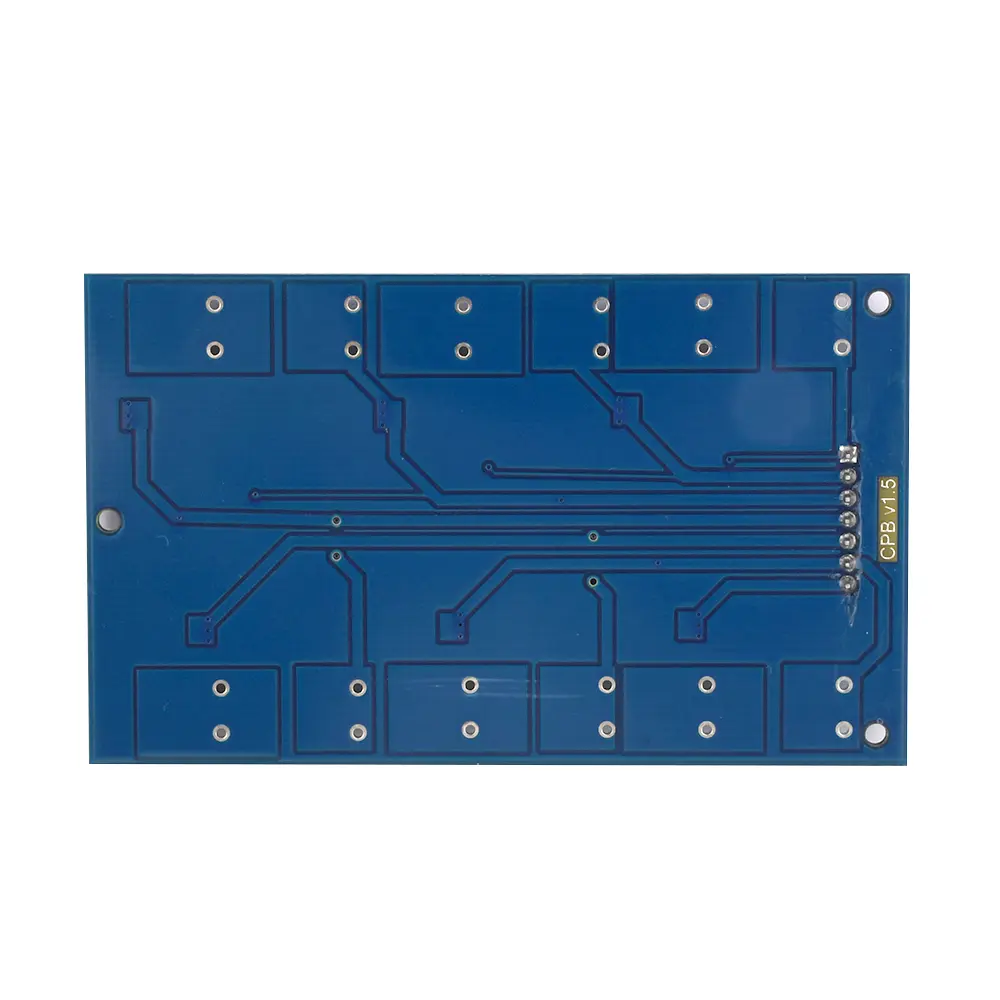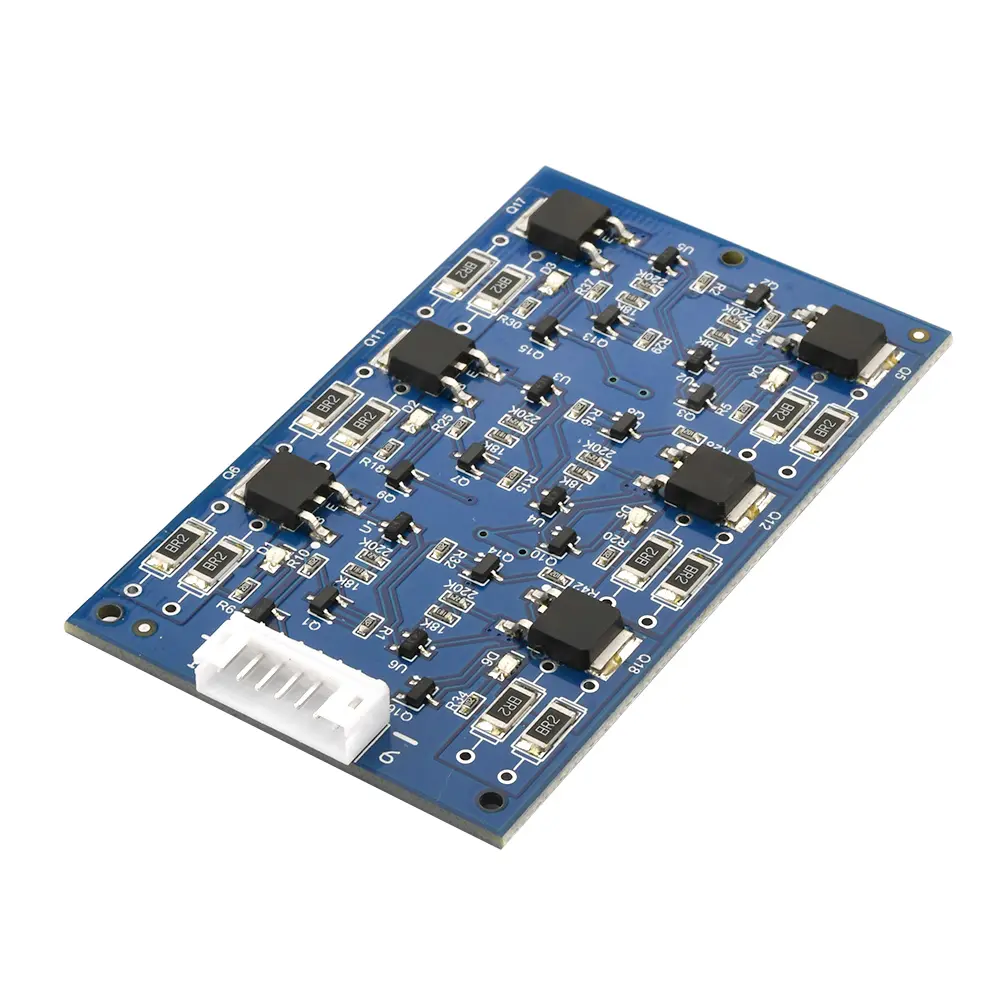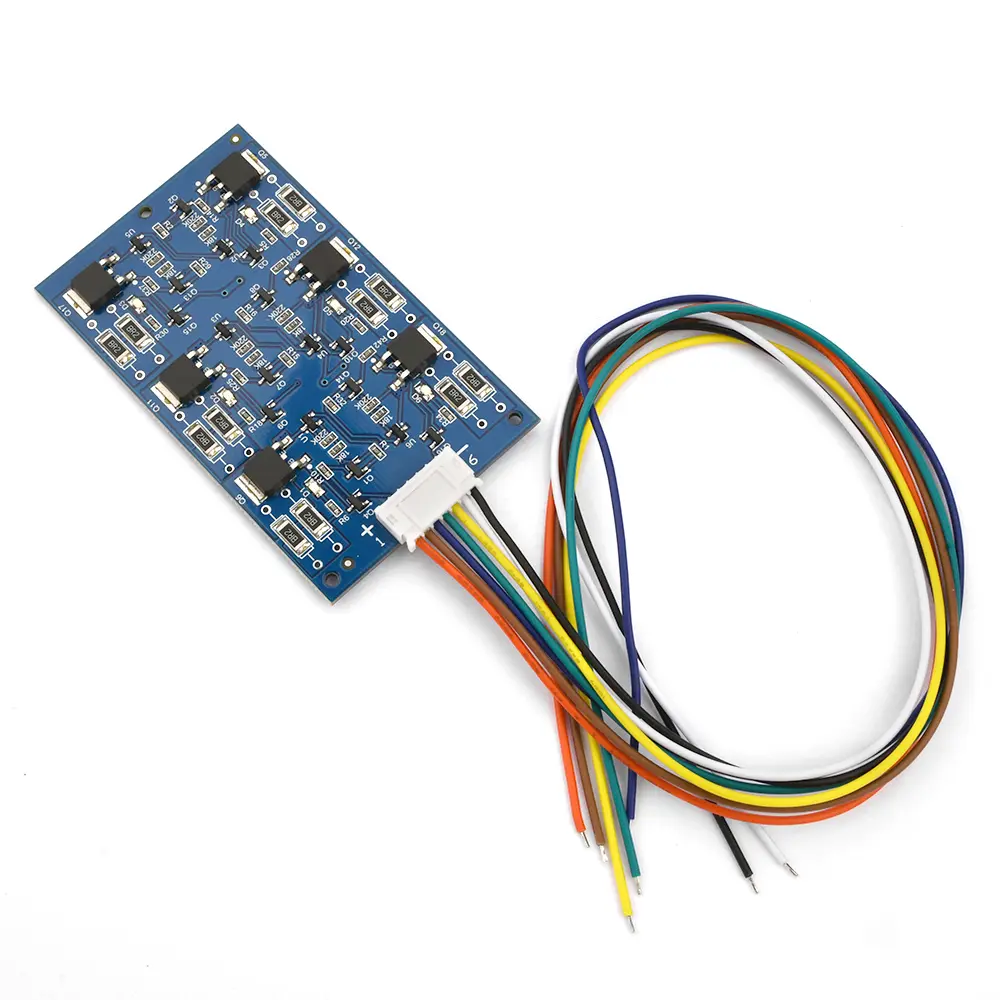2.7V/16V 6S Lithium Titanate Battery Protection Board Farad Capacitor Balance Board Equalization Circuit
<div class="detailmodule_html"><div class="detail-desc-decorate-richtext"><p><span style="font-size:20px"><strong>Features:</strong></span><br/>1.This protection board belongs to passive equalization and is used for 1-6 series farad capacitors and lithium titanate batteries;<br/>2.This protective board is suitable for 2.7V lithium titanate batteries and 2.7V farad capacitors, and other types of batteries are not suitable;<br/>3.The balanced current is about 0.7A, and the default protection voltage is 2.7V. The minimum can be changed to 2.5V, and the maximum is recommended not to exceed 3V;<br/>4.There is an indicator light indicating the working status of the protection board. When the unit voltage exceeds 2.7V, the corresponding indicator light will light up and the corresponding discharge circuit will start discharging. When the corresponding unit voltage drops below 2.7V, the indicator light will go out and the circuit will stop discharging;<br/>5.The charging and discharging of the capacitor/battery pack do not directly pass through the protective plate, so the charging and discharging current is not limited and can be used in applications with extremely high discharge current.</p><p><span style="font-size:20px"><strong>Parameters:</strong></span><br/>Type: supercapacitor/farad capacitor<br/>Balancing method: passive balancing<br/>Equalizing voltage: 2.7V<br/>Equalizing current: 0.7A<br/>Static current: 60uA<br/>Charging current: unlimited<br/>Discharge current: unlimited<br/>Working temperature: -20-100 ℃<br/>Protection plate size: 76mmX46mm<br/>Cable length: approximately 30cm<br/><span style="font-size:20px"><strong>Wiring instructions:</strong></span><br/>Please refer to the wiring diagram for wiring, starting from the negative pole of the battery pack. The first line marked with "-" on the protection board is connected to the negative pole of the first battery, and the second line is connected to the connecting pieces of the first and second batteries. Continue connecting in sequence until it is connected to the positive pole of the entire battery pack. Multiple protection plates are connected in series. Please connect the seventh line of the upper protection plate and the first line of the lower protection plate together to the connection plate between the sixth and seventh batteries.<br/><span style="font-size:20px"><strong>Change voltage description:</strong></span><br/>If you need to change the protection voltage, please search for "Online Calculator for Voltage Dividing Resistance". The input voltage is the voltage you want to modify, and other parameters are entered as shown in the figure below. The calculated resistance value is in kiloohms (the maximum cannot exceed 50 kiloohms, otherwise the parallel resistance Rb will need to be changed to 110 kiloohms).<br/>There are 2 voltage divider resistors in each circuit, with a total of 12 resistors in 6 circuits. The resistor labeled 18K on the board is a series resistor. Generally, only this resistor needs to be changed.<br/>Reference voltage resistance value:<br/>2.5V-0 Ohms<br/>2.6V-9.1 kiloohms<br/>2.65V-13 kiloohms<br/>2.7V-18 kiloohms<br/>2.75V-22 kiloohms<br/>2.8V-27 kiloohms</p><p><span style="font-size:20px"><strong>Frequently asked questions:</strong></span><br/>The use of protective boards requires the buyer to have at least a certain level of circuit knowledge. Please carefully read the product introduction:<br/>1. Which batteries/capacitors can this protection board protect, and what is the protection voltage and balanced current? What is the charging and discharging voltage and current of the protective board?<br/>This protective board is suitable for 2.7V lithium titanate batteries and 2.7V farad capacitors, and other types of batteries are not suitable. The balanced current is about 0.7A, and the default protection voltage is 2.7V. The minimum voltage can be changed to 2.5V, and the maximum recommended value is not more than 3V (the higher the voltage, the greater the discharge current, and exceeding the rated power of the discharge resistor will burn out the discharge resistor)<br/>The charging and discharging of capacitors/battery packs do not directly pass through the protective plate, so there is no limit to the charging and discharging current, and can be used in applications with extremely high discharge currents. The charging voltage is determined based on the number of strings, and the maximum charging voltage does not exceed (strings * 2.7) V.<br/>2. How many strings of batteries/capacitors is this protective board suitable for?<br/>A single protective board is suitable for any 1-6 strings of batteries/capacitors. When the number of strings is less than 6, connect from the negative pole according to the wiring diagram, and leave the excess wires empty. Multiple protection boards in series can protect more strings (for example, 2 protection boards in series can protect up to 12 strings)<br/>3. Does this protection board have overvoltage and undervoltage protection? Is there an indicator light?<br/>The protection board only has limited overvoltage protection and does not have undervoltage protection. There is an indicator light indicating the working status of the protection board. When the unit voltage exceeds 2.7V, the corresponding indicator light will light up and the corresponding discharge circuit will start discharging. When the corresponding unit voltage drops below 2.7V, the indicator light will go out and the circuit will stop discharging.<br/>Does this protective board have the function of equalizing voltage?<br/>This protection board is passive equalization, and the discharge circuit is only activated when the voltage exceeds the protection voltage. Therefore, to equalize the voltage, it is necessary to set the charging voltage slightly higher than the protection voltage to initiate full equalization. The following operation is a manual operation for capacitors/battery packs with a large voltage difference. If the voltage difference is not significant, it is not necessary to do so.<br/>For example, for 6 2.7V capacitor banks, set the charging voltage to 16.5V (approximately 0.3V higher than the total protection voltage of 16.2V), set the charging current to 0.5A (not exceeding 0.5A), and then continue charging for 2-4 hours after fully charging<br/>5. The 0.7A discharge current of the protective board is a bit small, can it be increased?<br/>Yes, this protective board has reserved welding holes for the power resistor, which can be connected in parallel with the color ring resistor to increase the current. After the discharge current increases, the working power of the entire protective board will increase. Our store is not responsible for any possible damage to the protective board or capacitor or any fire caused!</p><p><span style="font-size:20px"><strong>Package include:</strong></span><br/>1x protective board<br/>1X flat cable<br/><br/></p></div></div><p><br/></p>
$13.85
$7.1
- Category : Consumer Electronics
- Brand : diy_electronics_module_999_store DIY Electronics Module 999 Store
Colors
Sizes
-
+
<div class="detailmodule_html"><div class="detail-desc-decorate-richtext"><p><span style="font-size:20px"><strong>Features:</strong></span><br/>1.This protection board belongs to passive equalization and is used for 1-6 series farad capacitors and lithium titanate batteries;<br/>2.This protective board is suitable for 2.7V lithium titanate batteries and 2.7V farad capacitors, and other types of batteries are not suitable;<br/>3.The balanced current is about 0.7A, and the default protection voltage is 2.7V. The minimum can be changed to 2.5V, and the maximum is recommended not to exceed 3V;<br/>4.There is an indicator light indicating the working status of the protection board. When the unit voltage exceeds 2.7V, the corresponding indicator light will light up and the corresponding discharge circuit will start discharging. When the corresponding unit voltage drops below 2.7V, the indicator light will go out and the circuit will stop discharging;<br/>5.The charging and discharging of the capacitor/battery pack do not directly pass through the protective plate, so the charging and discharging current is not limited and can be used in applications with extremely high discharge current.</p><p><span style="font-size:20px"><strong>Parameters:</strong></span><br/>Type: supercapacitor/farad capacitor<br/>Balancing method: passive balancing<br/>Equalizing voltage: 2.7V<br/>Equalizing current: 0.7A<br/>Static current: 60uA<br/>Charging current: unlimited<br/>Discharge current: unlimited<br/>Working temperature: -20-100 ℃<br/>Protection plate size: 76mmX46mm<br/>Cable length: approximately 30cm<br/><span style="font-size:20px"><strong>Wiring instructions:</strong></span><br/>Please refer to the wiring diagram for wiring, starting from the negative pole of the battery pack. The first line marked with "-" on the protection board is connected to the negative pole of the first battery, and the second line is connected to the connecting pieces of the first and second batteries. Continue connecting in sequence until it is connected to the positive pole of the entire battery pack. Multiple protection plates are connected in series. Please connect the seventh line of the upper protection plate and the first line of the lower protection plate together to the connection plate between the sixth and seventh batteries.<br/><span style="font-size:20px"><strong>Change voltage description:</strong></span><br/>If you need to change the protection voltage, please search for "Online Calculator for Voltage Dividing Resistance". The input voltage is the voltage you want to modify, and other parameters are entered as shown in the figure below. The calculated resistance value is in kiloohms (the maximum cannot exceed 50 kiloohms, otherwise the parallel resistance Rb will need to be changed to 110 kiloohms).<br/>There are 2 voltage divider resistors in each circuit, with a total of 12 resistors in 6 circuits. The resistor labeled 18K on the board is a series resistor. Generally, only this resistor needs to be changed.<br/>Reference voltage resistance value:<br/>2.5V-0 Ohms<br/>2.6V-9.1 kiloohms<br/>2.65V-13 kiloohms<br/>2.7V-18 kiloohms<br/>2.75V-22 kiloohms<br/>2.8V-27 kiloohms</p><p><span style="font-size:20px"><strong>Frequently asked questions:</strong></span><br/>The use of protective boards requires the buyer to have at least a certain level of circuit knowledge. Please carefully read the product introduction:<br/>1. Which batteries/capacitors can this protection board protect, and what is the protection voltage and balanced current? What is the charging and discharging voltage and current of the protective board?<br/>This protective board is suitable for 2.7V lithium titanate batteries and 2.7V farad capacitors, and other types of batteries are not suitable. The balanced current is about 0.7A, and the default protection voltage is 2.7V. The minimum voltage can be changed to 2.5V, and the maximum recommended value is not more than 3V (the higher the voltage, the greater the discharge current, and exceeding the rated power of the discharge resistor will burn out the discharge resistor)<br/>The charging and discharging of capacitors/battery packs do not directly pass through the protective plate, so there is no limit to the charging and discharging current, and can be used in applications with extremely high discharge currents. The charging voltage is determined based on the number of strings, and the maximum charging voltage does not exceed (strings * 2.7) V.<br/>2. How many strings of batteries/capacitors is this protective board suitable for?<br/>A single protective board is suitable for any 1-6 strings of batteries/capacitors. When the number of strings is less than 6, connect from the negative pole according to the wiring diagram, and leave the excess wires empty. Multiple protection boards in series can protect more strings (for example, 2 protection boards in series can protect up to 12 strings)<br/>3. Does this protection board have overvoltage and undervoltage protection? Is there an indicator light?<br/>The protection board only has limited overvoltage protection and does not have undervoltage protection. There is an indicator light indicating the working status of the protection board. When the unit voltage exceeds 2.7V, the corresponding indicator light will light up and the corresponding discharge circuit will start discharging. When the corresponding unit voltage drops below 2.7V, the indicator light will go out and the circuit will stop discharging.<br/>Does this protective board have the function of equalizing voltage?<br/>This protection board is passive equalization, and the discharge circuit is only activated when the voltage exceeds the protection voltage. Therefore, to equalize the voltage, it is necessary to set the charging voltage slightly higher than the protection voltage to initiate full equalization. The following operation is a manual operation for capacitors/battery packs with a large voltage difference. If the voltage difference is not significant, it is not necessary to do so.<br/>For example, for 6 2.7V capacitor banks, set the charging voltage to 16.5V (approximately 0.3V higher than the total protection voltage of 16.2V), set the charging current to 0.5A (not exceeding 0.5A), and then continue charging for 2-4 hours after fully charging<br/>5. The 0.7A discharge current of the protective board is a bit small, can it be increased?<br/>Yes, this protective board has reserved welding holes for the power resistor, which can be connected in parallel with the color ring resistor to increase the current. After the discharge current increases, the working power of the entire protective board will increase. Our store is not responsible for any possible damage to the protective board or capacitor or any fire caused!</p><p><span style="font-size:20px"><strong>Package include:</strong></span><br/>1x protective board<br/>1X flat cable<br/><br/></p></div></div><p><br/></p>
